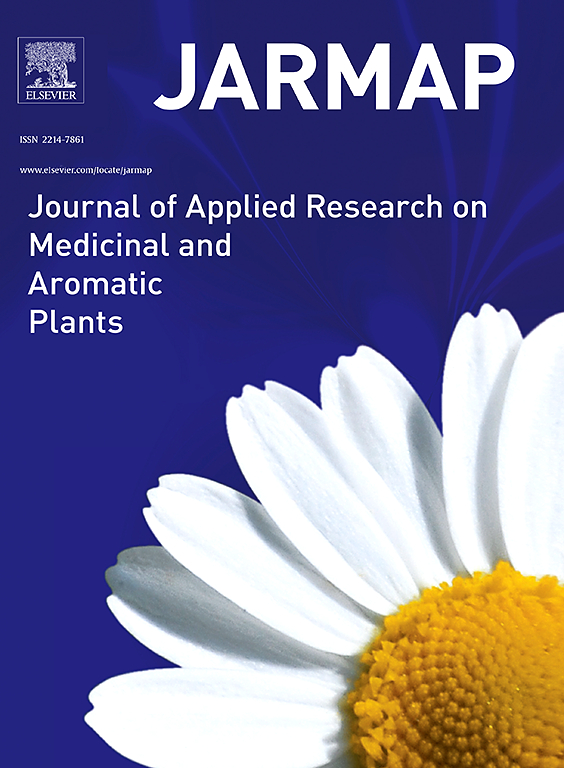Temperature-dependent variations in saffron (Crocus sativus L.) quality: A GIS-based suitability analysis of apocarotenoid concentrations
IF 3.6
2区 农林科学
Q1 PLANT SCIENCES
Journal of Applied Research on Medicinal and Aromatic Plants
Pub Date : 2025-08-15
DOI:10.1016/j.jarmap.2025.100654
引用次数: 0
Abstract
The quality of saffron (Crocus sativus L.) stigma is determined through its apocarotenoid content, especially crocin, picrocrocin, and safranal (C-P-S), which affect its dye, flavour and fragrance, respectively. This study provides a GIS-based technique to assess land suitability for saffron cultivation, emphasizing the crucial role of summer temperature in optimizing C-P-S concentrations. Data were collected from 23 saffron fields, where C-P-S content was quantified using High-Performance Liquid Chromatography (HPLC). Long-term temperature data were extracted from TerraClimate database using Google Earth Engine and analyzed in a GIS environment to identify optimal summer temperature ranges. Optimal temperature ranges were established based on conditions observed in the best-performing fields, with deviations classified as suboptimal. These temperature thresholds were used to define climatic and quality zones, resulting in the identification of 34 climatic zones and 71 stigma quality zones across the studied provinces. Results indicate that only 5 % of the total arable land falls within the highest-quality zone, with the most suitable regions located in Razavi Khorasan Province. A strong negative correlation was observed between increasing summer temperatures and declining crocin and picrocrocin levels, demonstrating a temperature-sensitive response. These findings provide a perspective for agricultural decision-makers and support the development of climate-adaptive strategies for saffron cultivation.
藏红花(Crocus sativus L.)品质的温度依赖性变化:基于gis的类麻瓜素浓度适宜性分析
藏红花(Crocus sativus L.)柱头的质量是通过其类伪胡萝卜素含量来决定的,尤其是藏红花素、微藏红花素和番红花醛(C-P-S),它们分别影响其染色、风味和香味。本研究提供了一种基于gis的藏红花种植土地适宜性评估技术,强调夏季温度在优化C-P-S浓度中的关键作用。采用高效液相色谱法(HPLC)对23块藏红花地的C-P-S含量进行定量分析。利用谷歌Earth Engine从terrclimate数据库中提取长期温度数据,并在GIS环境下进行分析,以确定夏季最佳温度范围。最佳温度范围是根据在最佳油田中观察到的条件确定的,偏差被归类为次优。利用这些温度阈值来定义气候区和质量区,最终确定了34个气候带和71个柱头质量区。结果表明,最高质量区域仅占总耕地面积的5 %,最适宜的区域位于呼罗珊省的拉扎维。在夏季温度升高与藏红花素和微苦藏红花素水平下降之间观察到强烈的负相关,表明温度敏感反应。这些发现为农业决策者提供了一个视角,并支持藏红花种植气候适应策略的发展。
本文章由计算机程序翻译,如有差异,请以英文原文为准。
求助全文
约1分钟内获得全文
求助全文
来源期刊

Journal of Applied Research on Medicinal and Aromatic Plants
Pharmacology, Toxicology and Pharmaceutics-Drug Discovery
CiteScore
6.40
自引率
7.70%
发文量
80
审稿时长
41 days
期刊介绍:
JARMAP is a peer reviewed and multidisciplinary communication platform, covering all aspects of the raw material supply chain of medicinal and aromatic plants. JARMAP aims to improve production of tailor made commodities by addressing the various requirements of manufacturers of herbal medicines, herbal teas, seasoning herbs, food and feed supplements and cosmetics. JARMAP covers research on genetic resources, breeding, wild-collection, domestication, propagation, cultivation, phytopathology and plant protection, mechanization, conservation, processing, quality assurance, analytics and economics. JARMAP publishes reviews, original research articles and short communications related to research.
 求助内容:
求助内容: 应助结果提醒方式:
应助结果提醒方式:


